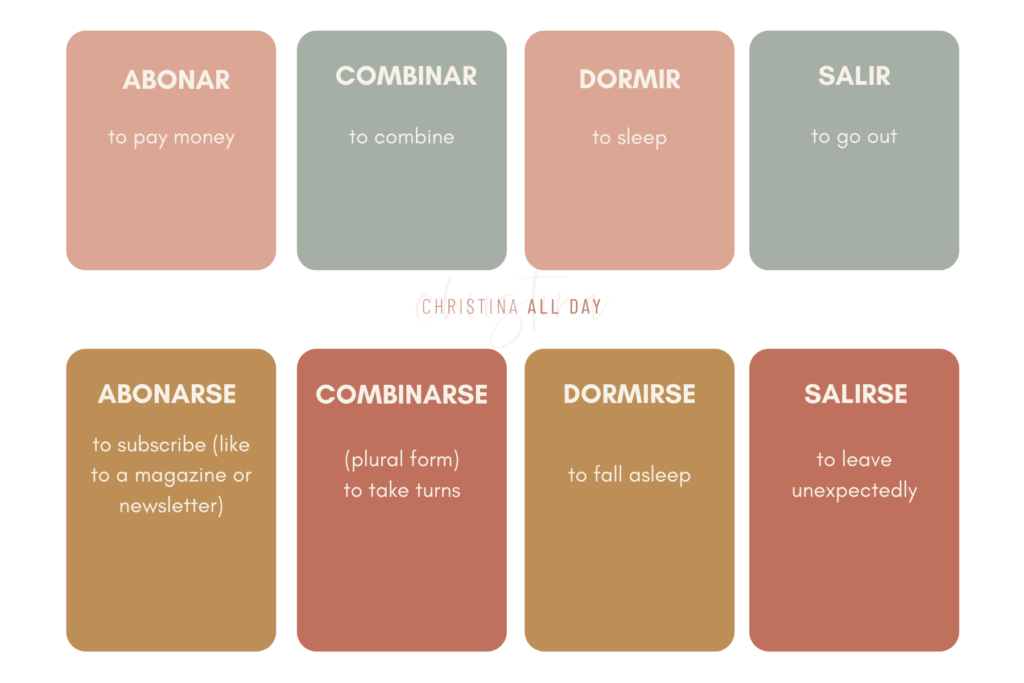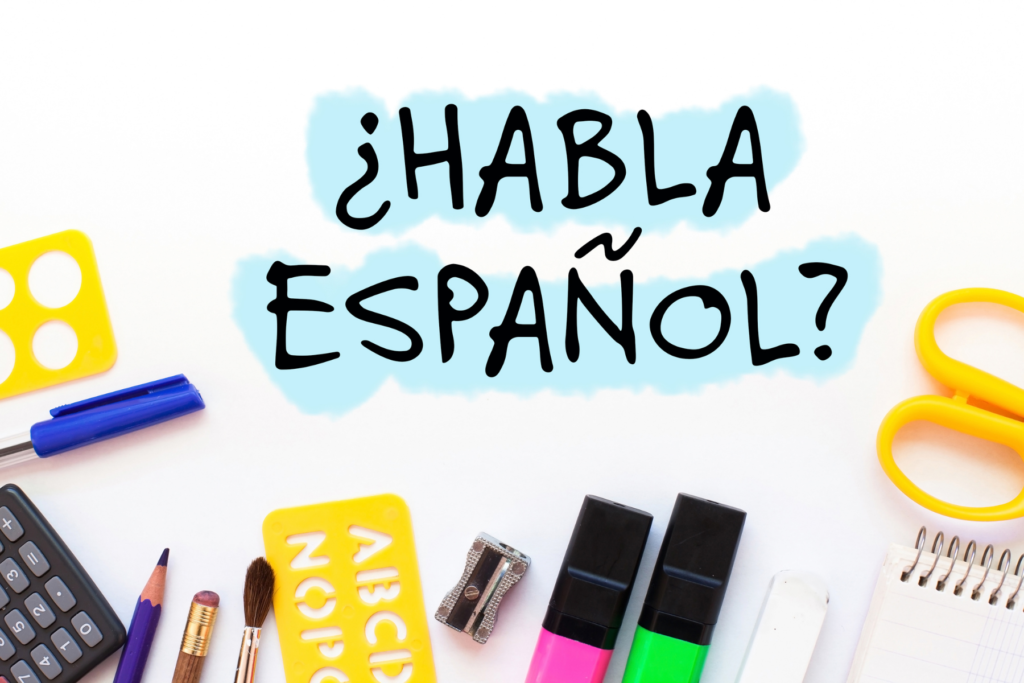What is a reflexive verb? A verb is used reflexively when the subject of the verb is also its direct object.
Because I’ve been trying to learn Spanish for decades (I know, I need to try harder) and my kids are in a bilingual school, I thought it’d be helpful to go through this in Spanish, but don’t worry, it will also help you in English and any other language you speak or are learning to speak.
Reflexive Verbs in Spanish
A simple sentence with a reflexive verb in Spanish is “Peter se lava” (Peter washes himself). In this sentence, Peter is both the subject (the one who washes) and the object (the person who is washed). This is pretty common when you speak about personal care, personal hygiene, or self-care. (My favorite kind of care.)
Note that the reflexive pronoun (in this case, se) usually comes before the verb in Spanish, although it can also be attached to the verb.
Even more so in Spanish than in English, reflexive verbs (verbos reflexivos) are also known as pronominal (pronoun) verbs (verbos pronominales). A pronominal verb is introduced by the reflexive pronouns “me, te, se, nous” and “vous” to involve the subject in action.
How to Remember Spanish Reflexive Verbs
- The subject and the direct object of a reflexive verb are the same. Por ejemplo, “She is looking at herself in the mirror.” (Again, personal care or mention of your own body or body part.)
- Not all Spanish reflexive verbs are translated as reflexive in English.
- Spanish reflexive verbs can be used to emphasize or avoid telling who is acting as the verb.
Here are the main ways these verbs are used.
As in the examples above, this is the most direct use of reflexive verbs and the most common way they are used in English. In the plural form, the pronoun can often be translated as “themselves” or “each other,” depending on the context. Some examples:
- Puedo verme en el espejo. (I can see myself in the mirror.)
- ¿Qué te compraste? (What did you buy for yourself ?)
- Se estaban admirando. (They were admiring each other.)
- Colin se habla. (Colin talks to himself.)
When a verb expresses the action of two or more nouns acting on each other – as in “se golpearon” for “they were hitting each other” – these can also be known as reciprocal verbs because they express a reciprocal action.
Chances are you, you speak like this in your first language and don’t know how to describe the grammar in these terms. That’s fine. I’m just sharing those details here since this is more of an educational post that will hopefully help you with any schoolwork or learning you’re doing on your own. I’ll get into more of this at the end of this post and after I share more examples of reflexive verbs.
If you need to clarify or emphasize that two subjects are acting on each other, one can add a word or phrases like mutuamente or el uno al otro (with possible changes in number and gender), like this:
- Se ayudaron el uno a la otra. (They helped each other.)
- Mi amiga y yo nunca nos vemos mutuamente. (My friend and I never see each other.)

Spanish Verbs Used Only In The Reflexive Form
Some verbs in Spanish are used only in the reflexive form and are not always translated into English utilizing a reflexive construction. These verbs are traditionally listed in dictionaries with an if at the end of the infinitive, as in abstenerse, meaning “to abstain.”
- Me abstengo de votar. (I am abstaining from voting.)
- Christina se arrepentió de sus erros. (Christina regretted her mistakes.)
- Me resigno a dinero sin tener. (I am resigning myself to having no money.)
English has very few verbs that have only one reflexive use. The most common is “perjuro“, as in “He perjured himself”.
In my opinion, the hardest part of learning Spanish is conjugating the verbs. This last example (it’s NOT a simple example) is the biggest struggle for me, so I’m open to learning tips from you if you have them! Just find me on Instagram at @ChristinaAllDay or let me know in the comment section here.
Spanish Verbs That Change Meaning In The Reflexive Form
Making a verb reflexive can change its meaning in ways that are not always predictable. Sometimes the different meaning is subtle. The following are some common examples to give you a better understanding of what I mean. (Again, why I find Spanish so hard to learn.)
- abonar, to pay money; abonarse, to subscribe (like to a magazine or newsletter)
- abrir, to open; abrir, to open oneself emotionally (to trust someone)
- acordar, to agree, to decide; acordarse to remember
- acusar, to accuse; acusarse, to confess
- cerrar, to close; cerrar, to emotionally close oneself
- combinar, to combine; combinarse (plural form), to take turns
- dormir, to sleep; dormirse, to fall asleep
- ir, to go; irse go away
- llevar, to transport or move; llevarse, to take away
- poner, to put on; ponerse, to put on, to dress
- salir, to go out; salirse, to leave unexpectedly
Notice the se ending on those words? Have I mentioned Spanish reflexive pronouns and verb conjugation really throws me for a loop yet?!

Spanish Reflexive Verbs For Emphasis
Some verbs can be used reflexively to add emphasis. The distinction is not always translated into English perfectly, like some of the words and phrases mentioned above.
For example, “comí la emparedado” means “I ate the sandwich,” but the reflexive form, “me comí la emparedado“, can be translated the same way, or perhaps as “I ate the whole sandwich.” Similarly, “piénsalo” can be translated as “think about it,” while “piénsatelo” can be translated the same way or as “think hard about it.”
The “Passive Reflexive”
Frequently, particularly with inanimate objects (which is a thing that is not alive, such as a rock, a chair, a book, etc.), the reflexive form is used to indicate something happening without revealing the person or thing responsible for it. These uses of the reflexive are usually the same to the passive verb forms in English, like:
- Se cerraron las puertas. (The doors were closed.)
- Se habla español aquí. (Spanish is spoken here.)
- Se venden recuerdos. (Souvenirs are sold, or souvenirs are for sale.)
Spanish Reflexive Verbs For Emotional Reactions
Reflexive verb forms indicate emotional reactions many times, so focus on the action of the verb.
For example, enojar means “to irritate.” The reflexive enojarse means “to get angry” or “to become angry.” So, “se enoja contra su amigo” could be used to say “he gets angry at his friend.” Some verbs used in a reflexive sentence include:
- aburrirse, “to be bored”
- alegrarse, “to be happy”
- dolerante, “to be hurt”
- emocionarse, “to be excited”
- horrizarse, “to be horrified”
- sorprenderse, “to be surprised”
If you are learning Spanish and understand that last paragraph above, please feel free to find me on Instagram at @ChristinaAllDay or let me know in the comment section how you are learning Spanish.

Thankfully, I had someone help me put this post together because a lot of it is over my head, but remember, if you can’t explain how you speak your first language like this, you can learn another language without knowing the formal terminology of how you speak and why you speak that way.
For example, in English, I am not mindful when I use a subject pronoun, a word in infinite form, what a subject of the sentence is, and when I use a personal pronoun or a conjugated verb and indirect object pronouns. Then there’s first-person, second-person, third person… I could go on. You get the point.
I think the secret to learning another language is to use the words and sentences in your daily routines, following examples by other Spanish speakers, and even learning from English speakers how they learned other languages.
You definitely need to be in a specific state of mind to be consistent with learning the Spanish language. It’s the only way, so spill your language learning secrets with me if you can!
